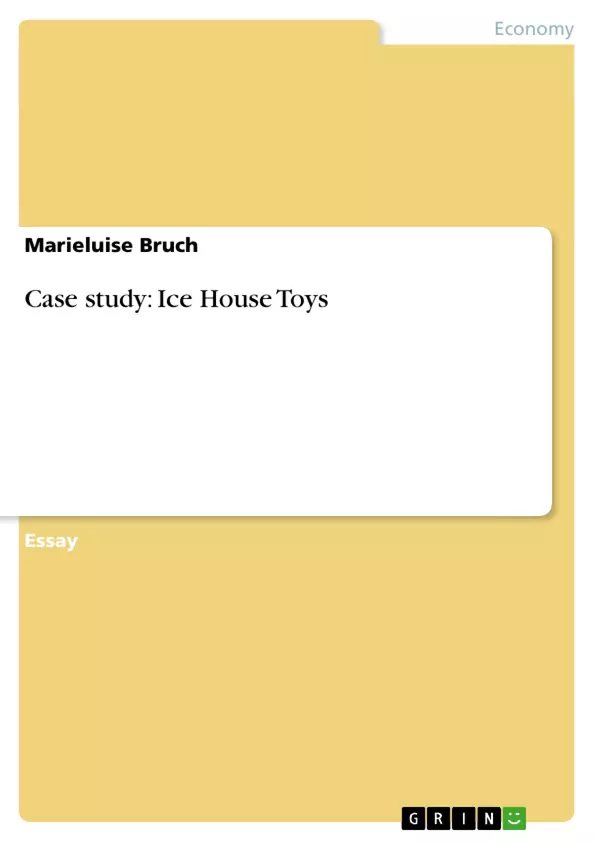Ice House Toys is a company which consists of five shops and one mail-order business. The mail-order operations are situated in a warehouse in Bristol. This building consists three floors, each 1200 square metres. Every year Ice House Toys send three catalogues with about 300 different toys and games, all manufactured in UK, Europe and the Far East. The major of this catalogues is the Christmas catalogue which is sent to 160,000 customers resulting in 22,600 orders with an average order value of £42. The winter and spring catalogues are sent to 90,000 customers. This results in 6,900 orders with an average order value of £23. The stock for the Christmas sales is ordered by the end of July and received in two phases. 75 percent arrives in the first week of October and filled the stock areas to capacity. The remaining orders come after the first 2,500 orders have been processed in the fourth week of November. In 1999, stock with a resale value of £1.1m was ordered.
The mail-order operation is divided into three stages: recording, assembly and packing and dispatch. Robin Baker, the Managing Director of Ice House Toys, plans three main changes for the mail-order operation. Firstly, he will do an agreement with a company which sells upmarket children’s clothes. This will lead to 30,000 new names and addresses of customers. Secondly, Ice House Toys will spend further £18,000 on advertising because each £1,000 led to 190 additional orders in the past. And the last future change will be the newly created website. On this the user can find detailed description and photographs of each item. The ordering will be easier because you will have a virtual shopping basket and send your order online to the company. The user has not to print the descriptions and codes. In the trial period the customer’s average order value was £60. Ice House Toys think that five per cent of their existing users will use this service.
Inhaltsverzeichnis (Table of Contents)
- Introduction
- Planning and control
- General overview
- Capacity constraints
- Extension of the warehouse capacity
- Other methods to overcome capacity constraints
- The new website
- Long-term capacity planning
- Alternative purchasing policy
- Just-In-Time in general
- Just-In-Time in Ice House Toys
- Overtime payment
- Summary
Zielsetzung und Themenschwerpunkte (Objectives and Key Themes)
This case study examines the planning and control challenges faced by Ice House Toys, a mail-order toy company, as it expands its operations. The study aims to analyze the company's existing processes and propose solutions to address capacity constraints and optimize its supply chain.
- Capacity planning and control
- Just-in-Time (JIT) inventory management
- Overtime payment
- Warehouse space constraints
- Supply chain management
Zusammenfassung der Kapitel (Chapter Summaries)
- Introduction: This chapter introduces Ice House Toys, its business model, and the company's current operational challenges. The chapter highlights the increasing demand for toys during the Christmas season and the associated capacity constraints.
- Planning and control: This chapter explores the fundamental concepts of planning and control within operations management, emphasizing the importance of balancing these two elements. The chapter specifically focuses on capacity planning and control, examining the impact of capacity constraints on the company's operations.
- Long-term capacity planning: This chapter explores various long-term capacity planning strategies that Ice House Toys can employ to address its anticipated growth in the coming years.
- Alternative purchasing policy: This chapter delves into the Just-In-Time (JIT) inventory management system, discussing its principles and potential implementation within Ice House Toys. The chapter examines the benefits and challenges associated with adopting a JIT approach.
- Overtime payment: This chapter examines the potential need for overtime payment at Ice House Toys due to peak demand periods. The chapter explores the financial implications and operational considerations associated with overtime work.
Schlüsselwörter (Keywords)
This case study focuses on key topics such as operations management, capacity planning and control, supply chain management, Just-In-Time inventory, overtime payment, warehouse space constraints, and seasonal demand.
- Quote paper
- Marieluise Bruch (Author), 2004, Case study: Ice House Toys, Munich, GRIN Verlag, https://www.grin.com/document/38039



